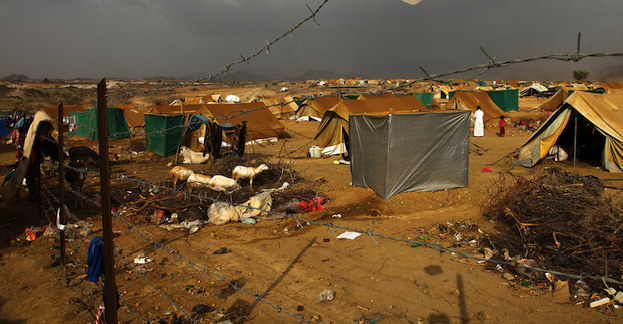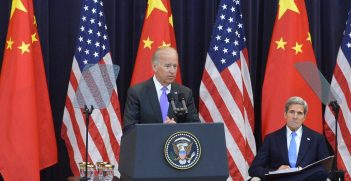Five Reasons Why Yemen Matters Now More than Ever

From the international nature of the conflict to its emerging refugee crisis, this is why the world needs to pay more attention to what is happening in Yemen.
A deadly civil war has ravaged Yemen for more than a year. Rampant violence and horrific conditions have driven millions from their homes—unchecked, the conflict in Yemen could become the source of the world’s next major refugee crisis. Unfortunately, the situation has failed to capture the public’s attention in the way that the war in Syria has. In a study published in March, on the first anniversary of the conflict, I explored how the crisis is growing exponentially worse by the month, as well as the consequences we will face if we fail to act.
Time is running out, but it is not yet too late. Despite the assumptions of many in the West, Yemen is not too small or too remote to matter. Here are five reasons why:
1. This is now the world’s worst humanitarian disaster.
Yemen has more people in need of humanitarian aid than any other country in the world, including Syria. Over 21 million people in Yemen—82 percent of the population—are in dire need of immediate life-saving assistance and face conditions that are simply horrifying. (Compare this to 13.5 million in Syria or 11 million in Iraq, according to the UN’s Office for the Coordination of Humanitarian Affairs.) Millions in Yemen are on the brink of starvation. The health care system has collapsed. Over 10,000 Yemeni children died last year from outbreaks of preventable diseases such as cholera and dysentery, diseases not seen in Canada since the 1800s. Thousands of innocent people have been caught in the crossfire and killed or injured.
The physical destruction is apocalyptic. Bombs have leveled neighborhoods, markets, schools, hospitals, roads and bridges. Entire sections of the Old City of Sanaa—a UNESCO World Heritage site over a thousand years old—have been flattened. Even if the war stopped tomorrow, Yemen’s people would still desperately need aid just to survive and rebuild. IfCanadians expect their government to be a world leader in human rights, we need to do more to address what is arguably the world’s worst humanitarian catastrophe.
2. It is already an international conflict.
Yemen’s conflict is more than just a domestic struggle between rebels and government. It has drawn in a wide array of actors seeking to influence the outcome or take advantage of the chaos:
- The Rebels: The civil war began in March, 2015, after Houthi rebels overran the capital and placed the president under house arrest. The Houthis are a Zaydi Shia group who have long sought a greater say in Yemen’s government. The group purportedly receives financial and military assistance from Iran; they also draw support from former Yemeni President Ali Abdallah Saleh—who was ousted during the Arab Spring—and from Yemeni security forces still loyal to him.
- The government and its allies: Worried that arch-rival Iran had set up shop in its own backyard, Saudi Arabia rushed to the support of the Yemeni government. Saudi Arabia, supported by a coalition of nine other Arab allies—Bahrain, Qatar, Kuwait, United Arab Emirates, Egypt, Jordan, Morocco, Senegal and Sudan—has conducted a brutal bombing campaign across Yemen. The United States and United Kingdom are indirectly involved, providing Saudi Arabia with billions of dollars in arms sales, training, logistical support and targeting assistance for air strikes. Even Canada has impact, given reports of Canadian-made armoured vehicles stationed on the Saudi-Yemen border.
- The terrorists: Al-Qaeda in the Arabian Peninsula (AQAP) and the so-called Islamic State are also active in Yemen. Both groups consider everyone else to be their enemy—the Houthis, the Yemeni government, the Saudi-coalition and even each other. AQAP and the Islamic State have taken advantage of the security vacuum to extend influence, gather and train recruits, and plot attacks against the West.
Many describe the conflict in Yemen as a sectarian “proxy war” between Sunni Saudi Arabia and Shia Iran, which diminishes the seriousness of Yemen’s internal divisions. The involvement of these two regional superpowers, however, plays into a larger struggle for influence in the Muslim world, and the wars in Yemen and Syria have inched Saudi Arabia and Iran dangerously close to open confrontation.
3. Both sides may be guilty of war crimes
In Yemen, there are no clear-cut good guys or bad guys, and it is the Yemeni people who suffer. Both sides have committed violations of international humanitarian law, including indiscriminate and widespread attacks on civilians, neighborhoods, hospitals, schools, markets and even trucks carrying humanitarian aid.
Some of the individual attacks are particularly chilling. Just last month, a Saudi-coalition strike on a market killed 97 people, including 25 children. In September, they hit a wedding, killing over 130 civilians, mostly women and children. Saudi planes have dropped U.S.-made cluster bombs on a Yemeni neighborhood, and on at least three separate instances, Saudi helicopters chased and shot at civilians running away from attacks on their homes.
The Houthis have committed equally deplorable acts against civilians. The Houthis have shelled children as they queued up for drinking water, played soccer in the street, or as they sat down for dinner with family. During a nearly year-long siege of the city of Taiz, Houthis rebels deliberately prevented food, water, fuel, medicine and other life-saving aid from reaching the city, placing 250,000 people in danger of starvation and death.
4. This could be the start of the next global refugee crisis.
The world failed to take serious action on the Syrian refugee crisis until nearly a million people poured across Europe’s borders. With Yemen, the past is poised to repeat itself. Over 2.8 million Yemenis have been forced to leave their homes; almost 180,000 have already fled the country.
Many of those fleeing Yemen cross the narrow Bab-el-Mandeb Strait and land in the Horn of Africa—the countries of Djibouti, Eritrea, Somalia and Ethiopia. These countries have been largely welcoming of refugees, but they are also struggling to handle their own development challenges, severe droughts, food crises, high unemployment and violent conflicts.
The journey from the Horn of Africa to Europe is dangerous but well-traveled. Migrants must first make their way over 1,500 kilometres to Khartoum, the capital of Sudan. There, they link up with traffickers, pack into overcrowded trucks, and make the multi-day journey across the scorching Sahara desert into Libya. In war-torn Libya, migrants and refugees can sometimes wait for months until they secure passage across the Mediterranean on rickety, overloaded boats. This migration path, the Central Mediterranean Route, is the deadliest sea route across the Mediterranean and has claimed thousands of lives.
Despite these perils, hundreds of thousands of migrants and refugees have already travelled this path from Africa to Europe. New refugees from Yemen are increasingly interested in these smuggling routes and are researching asylum procedures in Europe. Migration experts warn that once success stories start trickling back home, the floodgates could open. Many countries are already overwhelmed, and another mass influx of asylum seekers could push anti-refugee tensions in Europe to a breaking point.
5. It is not too late…yet.
We have the opportunity to save lives and prevent the next refugee crisis before it begins—but only if we act now. The United Nations and other international aid organizations working in Yemen desperately need cash to ensure basic survival for millions of people. Last year, the UN and its partners only received half of the USD$1.8 billion needed to provide critical humanitarian relief in Yemen and stave off a new refugee crisis. This may sound like a lot of money—but not when compared with the tens of billions the world has already spent reacting to the Syrian civil war and ensuing flood of refugees.
Of course, peace negotiations are the key to a long term solution. There is hope. Yemen has a long history of political instability, but an equally long history of negotiating political settlements. Sadly, the second round of talks fell through this week, after the Houthis violated the truce and seized a military base. The international community must pressure all parties—including the Yemeni government, Houthis, Saudi Arabia and Iran—to play a constructive role, support future negotiations, learn from the mistakes of past peace deals, and manage expectations. Any future transition process must not be rushed, should allow for enough time to implement meaningful change, and needs to truly address Yemen’s complex economic and social factors.
Jacqueline Lopour is a research associate with the Centre for International Governance Innovation (CIGI), an independent, nonpartisan think tank focused on international governance. This article originally appeared on Open Canada on 5 May. It is republished with permission.





